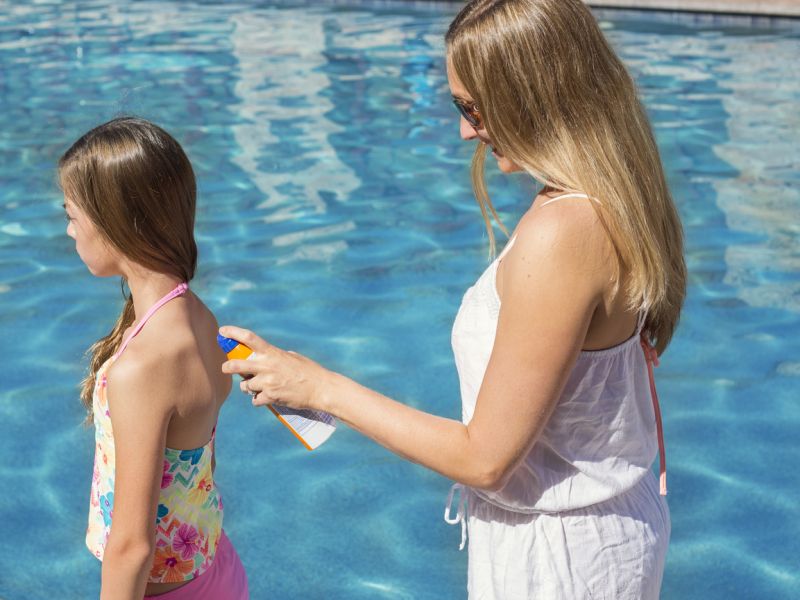Are DIY Sunscreens Dangerous?
By Alan MozesHealthDay Reporter

TUESDAY, May 21, 2019 (HealthDay News) -- Interest in homemade sunscreens is hot, but many of these do-it-yourself brews lack effective sun protection, a new study warns.
Researchers found that only about one-third of homemade sunscreens on the popular information-sharing website Pinterest specified how much sun protection factor (SPF) each "natural" sunblock contained. In some cases, SPF content dipped as low as 2 -- far below recommended guidelines for preventing premature aging and skin cancer.
Overall, about seven out of 10 sunscreen recipes failed to adequately protect skin from dangerous ultraviolet (UV) rays, the study authors found.
"It is a great sign that consumers are paying attention to what is in their products," said study author Julie Merten. She is an associate professor with the University of North Florida's Brooks College of Health.
But she and her colleagues are cautioning do-it-yourselfers to be mindful that if "they do use Pinterest to make their own sunscreen, to be sure it is a formula that offers true broadband protection."
Unlike commercial sunscreens, the Pinterest recipes aren't tested or regulated, and could cause harm, Merten and others said.
Merten acknowledged there are "legitimate concerns" about some commercial sunscreens, including reef habitat destruction and hormone-disrupting chemicals. These "align with a societal shift toward more natural and organic products," she noted.
Recently, a study from the University of California, San Francisco (UCSF), raised concerns regarding four common commercial-sunscreen chemicals: oxybenzone, avobenzone, octocrylene and ecamsule.
All four chemicals were found to have entered the users' bloodstreams at levels far exceeding U.S. Food and Drug Administration safety thresholds.
Still, the UCSF study team did not conclude that anyone's health was at risk. And some experts believe any concerns that might be raised are outweighed by the anti-cancer and anti-aging benefits of FDA-approved sunscreens.
One of those experts is Dr. Steven Wang, director of dermatology at Memorial Sloan Kettering Cancer Center, in Basking Ridge, N.J.
"There's tons of scientific data that sunscreen with SPF of at least 15 reduces the risk for both melanomas and squamous cell cancer, and prevents wrinkles and pigmentation. That's the benefit," said Wang.
"But in terms of why people would even think about making a sunscreen at home, I think that is probably based less on science than on fear," he said.
These are not easy products to make, according to Wang, who is also chair of the Skin Cancer Foundation's photobiology committee. "Some of the filters they contain are water-soluble, while others are oil-soluble. So molecules can separate, and the end result won't deliver the protection you're after. You can't just whip it together," he explained.
Using a do-it-yourself sunscreen that doesn't work could be more dangerous than using nothing at all, he warned. That's because "when you put oil on your skin without any blockers, you actually allow the UV rays to penetrate deeply into your skin," Wang said.
Merten said that could make users vulnerable to sunburn.
The bottom-line? People should be "very thorough in their research if they decide to use homemade sunscreens, and to use ingredients such as zinc and titanium oxide with proven UV blocking ability," Merten said.
The FDA recommends sunscreens with an SPF of 15 or more, while the American Academy of Dermatology's recommended minimum is SPF 30.
Most experts advise applying sunscreen a half hour before heading outdoors. Reapply at least every two hours, more often if you're swimming or sweating.
The report was published in the May 20 issue of Health Communication.
More information
To learn more about effective sunscreen use, visit the American Academy of Dermatology.

The news stories provided in Health News and our Health-E News Newsletter are a service of the nationally syndicated HealthDay® news and information company. Stories refer to national trends and breaking health news, and are not necessarily indicative of or always supported by our facility and providers. This information is provided for informational and educational purposes only, and is not intended to be a substitute for medical advice, diagnosis, or treatment.

